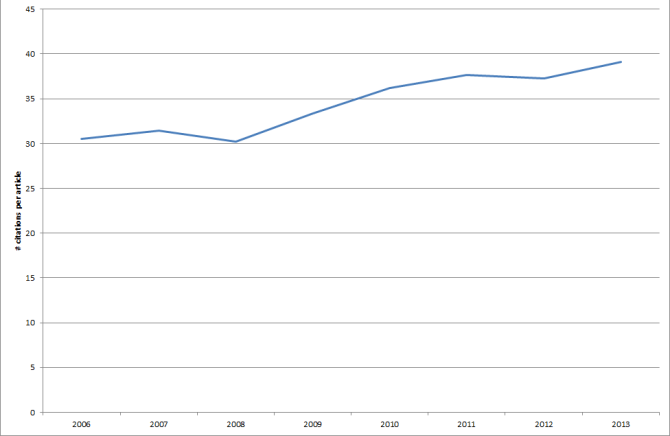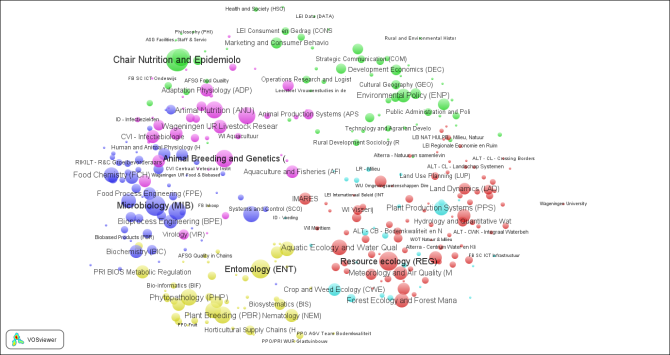
Estimation of relative journal importance for Wageningen University & Research groups
Good collection management is necessary to safeguard the quality, quantity and costs of the online journal collections of Wageningen University & Research (WUR). To make appropriate decisions regarding subscriptions to journals that are important for the research and educational activities the library analyses usage and costs of its online journal collections on a regular basis.
Usage data are obtained per journal title via the publisher who provides access to the journal after subscriptions have been arranged by the library. Usage data comes as the number of article downloads per journal title for the organization (here WUR as a whole) that subscribes to the journal in question. For good decision making and appropriate collection management, at the level of research groups, the library needs analyses of online journal usage for these research groups. With information on the usage of online journals per chair group, business-unit, research institute or science group the importance of these journals for the staff working in these organizational units of WUR can be estimated.
To estimate the usage of online journals per research group the library analyses the citation behaviour of the staff in the articles they have published over a certain period of time. To select articles published by WUR staff the bibliographic database Web of Science is used. These articles also have been included in Staff Publications, the WUR institutional repository, and a link can be established between the information on citation behaviour from Web of Science and affiliation data of the staff from the repository. The citation behaviour is reflected by the journals that have been included in the reference lists of the WUR articles and the affiliation data enable selection of different research groups where the authors of the articles work.
The library analysed citation behaviour in articles published by WUR staff in the years 2011-2013. For counting the citations per journal 8400 articles were analysed from 1830 journals.
The table below shows the number of citations per journal per year for the 10 most cited journals. Nature and Proceedings of the National Academy of Sciences of the United States of America received the most citations per year in WUR articles. Further analysis on the number of citations per journal reveals that 90% of all article citations by WUR staff can be obtained from 1858 (out of a total of 7928 cited journals) most cited journals.
| Journal | Nr. of citations | |||
| 2011 | 2012 | 2013 | 2011-2013 | |
| Proceedings of the National Academy of Sciences of the USA | 1582 | 1801 | 2098 | 5481 |
| Nature | 1496 | 1633 | 1898 | 5027 |
| Science | 1501 | 1629 | 1885 | 5015 |
| Applied and environmental microbiology | 847 | 917 | 1105 | 2869 |
| Journal of Dairy sciece | 906 | 758 | 1180 | 2844 |
| Plant physiology | 632 | 814 | 1007 | 2453 |
| Journal of agricultural and food chemistry | 604 | 563 | 865 | 2032 |
| Environmental science & technology | 455 | 796 | 731 | 1982 |
| The American journal of clinical nutrition | 529 | 673 | 769 | 1971 |
| Ecology: a publication of the Ecological society of America | 709 | 654 | 605 | 1968 |
In the graph below the average number of citations per Wageningen UR article is represented for the years 2006-2013. From the graph it follows that there is a general growing trend for increase in the number of cited articles per published Wageningen UR article over time.

The number of citations per journal gives an indication of the relative importance of this journal for WUR staff members. The linked affiliation data for the citing articles (published by WUR staff) enables the identification of important journals per research group and relative use per journal by the different research groups of WUR. Co-citations of scholarly journals by different research groups also reveal networks. The network in the figure below represents a network for 320 chair groups and business units based upon co-citing journals in articles they have published in the years 2011-2013. The size of the circle (and text) reflects the number of published articles in these years. The six different colours represent different clusters that follow from the network analysis. Generally, these clusters correspond with the five science groups of WUR; only some research groups of plant sciences (e.g. Plant Production Systems, Crop and Weed Ecology and Centre for Crop System Analysis) are clustered seperately and closely associated with the cluster for environmental sciences. The distance between the circles represent similarity in co-cited journals by the research groups. The figure and network analysis have been obtained with VOSviewer (van Eck & Waltman, 2013).

The number of citations each journal received from WUR articles published in 2011, 2012 and 2013 gives an indication of recent usage of that journal by WUR staff when writing their articles. When browsing the WUR Library collection of journals, lists of journals can be sorted by received citations over the last three years (i.e. journal importance). Sorting of journal lists is also possible by Impact Factor, SNIP or SJR.
If desired, the library can provide organizational units of WUR (e.g. chair groups, business units, institutes or science groups) with lists of most cited journals in the articles the staff of these units published in scholarly journals in 2011, 2012 and 2013. Only publications in journals covered by Web of Science and registered in Metis can be included in the analysis for making these lists of most cited journals. For further information you can contact marco.vanveller@wur.nl.
References:
Van Eck, N.J. & Waltman, L. (2013). VOSviewer version 1.5.5. Center for Science and Technology Studies. Leiden University. Available via http://www.vosviewer.com/.